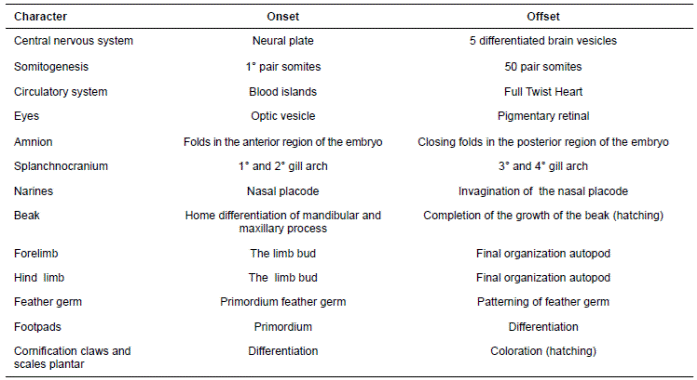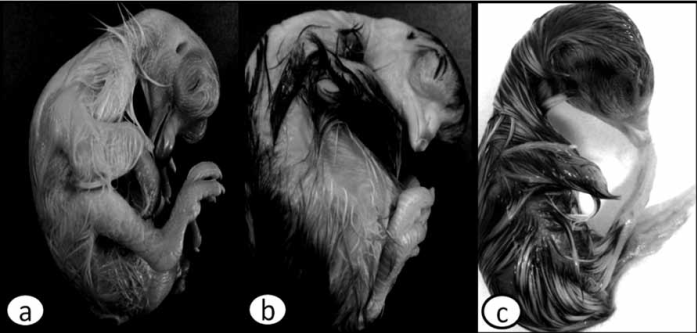Introduction
The term heterochrony refers to changes in time or relative rate of ontogenetic processes (Reilly et al., 1997). This concept is a persistent component of discussions about how evolution and development interact, and is a key concept in evolutionary biology (Reilly et al., 1997).
For the later developmental stages of vertebrate embryos, numerous available data show that specific differences are the result of allometric growth and/ or heterochrony (Gould, 1977; Raff and Wray, 1989; Mckinney and Mcnamara, 1991; Gould, 1992; Duboule, 1994; Smith, 2001; Azevedo, 2010).
Modern birds show a wide range of variation in functional maturity at hatching and dependence on parental care. According to this variation, birds have been separated in precocial and altricial, representing the extremes of a continuous spectrum from the full independence of the superprecocial moundbuilders (Megapodidae) to the total dependence of Passeriformes or Psittaciformes among other avian orders (Starck and Ricklefs, 1998).
Precocial hatchlings are covered with feather germ, have open eyes and well developed locomotion organs and are able to feed on their own. This mode of development is thought to be the ancestral condition of birds (Cracraft, 1981, 1988). Altricial development has evolved independently five or six times within the Aves clade (Starck and Ricklefs, 1998). Altricial hatchlings are blind, naked, with less developed locomotion organs, and are directly dependent on the parents for feeding (Portmann, 1955; Starck and Ricklefs, 1998).
Comparative embryonic prehatchling development between altricial and precocial birds has been poorly explored (Yamasaki and Tonosaki, 1988; Köppl et al., 2005; Ainsworth et al., 2009; Olea and Sandoval, 2012; Murray et al., 2013, Almeida et al., 2015) but this scarce information shows that growth rate is critical to characterize the development patterns and provides an excellent opportunity to analyze heterochronic events (Blom and Lilja 2005).
The onset and offset of thirteen morphological events were compared to identify possible heterochronic events that may relate to the altricial and precocious development patterns. Therefore, the objective of the present study was to analyze the ontogeny of three species of birds with two different development models: Columba livia (semialtricial 2) with an incubation period of 17 days, Coturnix coturnix and Gallus gallus domesticus (precocial 2) with incubation period of 16.5 and 21 days, respectively.
Material and methods
Obtaining embryos
Embryonated eggs of the three species were incubated in a stove at 36-37 °C and 40 to 50% humidity. Standard methods, set out in the Guide for Animal Euthanasia proposed by the IACUC (Institutional Animal Care and Use Committee) were used. The embryos were fixed in 10% formalin according to the following protocol: from 16 h of incubation, every hour for the first 5 days, then every 6 h for the next 5 days and finally every 12 h until hatching. For analysis under stereomicroscope the embryos were separated from the yolk and stained with methylene blue at 5%.
Analysis of embryo development
The embryos were examined under a stereoscopic microscope. Thirteen ontogenetic events were analysed (Table 1). The beginning (“onset”) and the ending (“offset”) of each were recorded during early (16 to 24), medium (24 a 38) and late (38 to hatchling) embryonic development stages. We used the normal stages of G. gallus domesticus embryo development (Hamburger and Hamilton, 1951) for establishing the stages. Embryo total length (TL), length of the forelimb (FL) and hind limb (HL) were recorded using an ocular micrometer.
Results
The sequence and timing during the thirteen events analyzed are shown in Figure 1.
In early stages, six events started and also finished earlier in C. livia compared to the quail and chick: central nervous system development, eyes, narines, and splanchnocranium development, circulatory system organization and somitogenesis. In the three species, the setup of the central nervous system, somitogenesis and narines lasted for a similar amount of time. In pigeons, eyes and circulatory system organization lasted three more than in C. coturnix and G. gallus domesticus, whereas splanchnocranium organization took four additional h.
The amnion folds appeared 9 h earlier in C. livia than in quail and chick. In C. coturnix, full development of amnion was completed in approximately 20 h, whereas in pigeons and chicks the same process took 12 h.
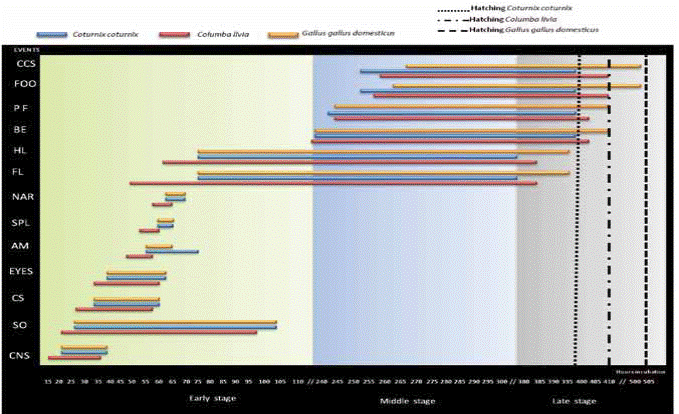
Figure 1 Sequence of ontogenetic events in Columba livia, Gallus gallus domesticus, and Coturnix coturnix. References: CNS: development of central nervous system, SO: somitogenesis, CS: heart organization, EYES: eyes organization, AM: amnion, SPL: splanchnocranium; NAR: narines, FL: forelimbs, HL: hind limbs, BE: beak, PF: pattern feather germ, FOO: footpads development, CCS: cornification claw and development of plantar scales.
Onset of limb formation and FL/TL and HL/TL ratios at the end of development differed between the species (Figure 1; Table 2). In C. livia the development of the limbs was asynchronous, with the fore-limb buds appearing after 44 h of incubation (stage 16) and the hind-limb buds after 52 h (stage 18); the development was completed in 336 h and 325 h, respectively. Both chicks and quails displayed synchronic development of the limbs. The buds appeared after 72 h of incubation (stage 18) in both species, but the offset of full development of members was different; it took 325 h in the quail and 310 h in the chick.
Table 2 Morphometric relationship in Columba livia, Coturnix coturnix and Gallus gallus domesticus at the end of the embryonic development.

Relation forelimb/total length (FL/TL) and relation hind limb/total length (HL/TL).
In the middle stage, formation of the beak began after 235 h of incubation in the dove and 5 hours later in Coturnix coturnix and Gallus gallus domesticus. Full development of the beak in Columba livia lasted 165 hours; this was 10 hours less than in chickens, being the beak length in pigeons longer than that reached in chickens and quails.
The three events that belong to the middle stage lasted longer in the chicken compared to the quail and pigeon (Figure 1 and 2).
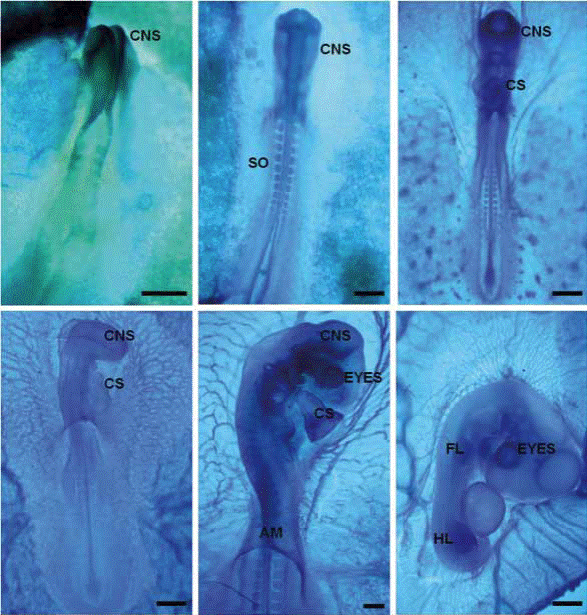
Figure 2 Sequence of ontogenetic events in Columba livia. References: CNS: central nervous system, SO: somitogenesis, CS: heart organization, EYES: eyes organization, AM: amnion, FL: forelimbs, HL: hind limbs. Scale: 0.5 cm.
In comparison with the chick and the pigeon, the establishment of the pattern of feather germ, and formation of footpads and scales of the forelimbs began and finished earlier in the quail. The two last events offset at hatching in three species (Figure 3). The offset of establishment of the pattern of feather germ finished at hatchling in the quail, 12 h before hatching in the pigeon, and 100 h in the chick. In the newly hatched birds of the three species, yolk is completely incorporated into the abdominal cavity.
However, they differed in eye size and pigeons showed bare skin in the loreal region.
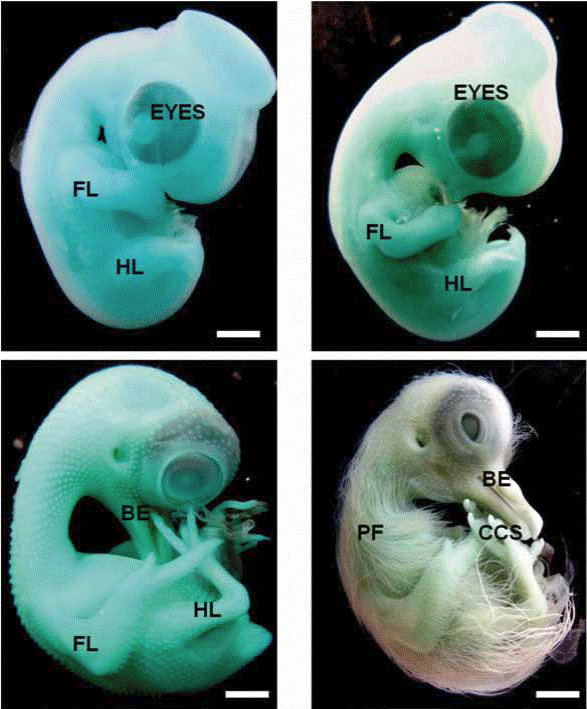
Figure 3 Sequence of ontogenetic events in Columba livia. References: EYES: eyes organization, FL: forelimbs, HL: hind limbs, BE: beak, PF: pattern feather germ, CCS: cornification claw and development of plantar scales. Scale: 0.5 cm.
The chick and quail hatchlings remained upright and making small movements at two h post-hatching, unlike pigeons that stayed until the 5th day posthatching without the ability to move (Figure 4).
Discussion
The study of heterochronic changes is based on the comparative development analysis of related taxa because there is too little information to make ancestor-descendant comparisons (Smith, 2001).
From the altricial-precocial perspective, the first step in the evolution of altricial birds from their precocial ancestors would have been smaller egg size and the shortening of the incubation period with the consequent earlier hatching chicks and development ending in the nest (Vleck and Vleck, 1987).
For describing and comparing ontogenetic trajectories, benchmark events as indicators of time should be defined to understand when the onset and offset of a morphogenetic event happens. When we compared ontogeny of C. livia, C. coturnix, and G. gallus domesticus, the sequence of events remained the same, but onset and offset times showed variations both at the early and middle stages. Variations in total duration were also observed.
In the early stage, six events (development of central nervous system, eyes, narines, splanchnocranium, circulatory system organization and somitogenesis) had an earlier onset and offset in the semialtricial C. livia compared to the precocious species C. coturnix and G. gallus domesticus. C. livia also presented different duration.
The pattern of limb bud development was different in the three species. In the quail and chick, the members developed synchronously, whereas in the pigeon, the forelimb bud appeared earlier and reached a larger relative size than the hind limb in more time. This asynchronous development could be explained by the modular pattern in the formation of the limbs. Modularity implies that the parts of an organism are built as separate but coherent modules. The modular units allow certain parts of the body to change in space and time without altering other structures (Gilbert, 2006, Nagai et al., 2011).
The relative size of the limbs at the time of hatching regarding total length were lower in C. coturnix than in G. gallus domesticus and C. livia. This variation could be explained as a result of different duration times. The limb-bud development was shorter in the quail compared to the chick and pigeon. In this latter species the prolonged development may allow wings and legs to reach a greater relative size at the end of the embryonic development. These different patterns may reflect different functional requirements (Blom and Lilja, 2005). Ontogeny of the fore limbs in the flightless emu (Dromaius novaehollandiae) and ostrich (Struthio camellus) has a slight delay in development regarding the hind limbs and a severe reduction in growth rate (Blom and Lilja, 2005; Nagai et al., 2011). In contrast, in the flying fieldfare (Tordus pilaris) the forelimb buds appear before the hind limb buds.
Acceleration of ontogenetic events (feather germ pattern, footpad formation, scale cornification and member development) in precocial species occur in the middle and later stages, and may explain how the quail reaches morphological development similar to that of G. gallus domesticus in a shorter incubation period.
Regarding the beak, the higher relative size reached by pigeons at hatching may be explained by accelerated development when compared with precocious species.
The amnion displays a heterocronic development. In the quail, the duration time was notably longer than in the chick and pigeon and the closure of folds spread to the onset of limb bud growth. This difference deserves further investigation.
Morphological variation analysis in both heterochronic growth and sequence heterochrony, offer a number of tools to interpret changes as a result of development (Fabrezi, 2012). Comprehensive developmental data is important to understand diversification of species and their relationships. In this study, the analysis of the variation of complete ontogenetic series corroborates that these differences reflect semi-altricial 2 (C. livia) and precocial 2 (C. coturnix and G. gallus domesticus) development patterns.
Comparative embryological studies covering different taxa and characters allow us to obtain a more comprehensive picture of the differences between development patterns even among closely related taxa as C. coturnix and G. gallus domesticus. The variability of events was evident in the late stage, allowing the two precocial species with different hours of incubation (16.5 and 21 days) to reach the same morphology at hatching.
Bird species with rapid growth and development allocate a large proportion of its initial growth to rapid development of “supply” for organs such as the gastrointestinal tract and liver (Portmann, 1955; Blom and Lilja, 2005). As a consequence, the growth of other “demand” organs is relatively delayed. For this reason, bird species with slow early development of brain, muscle and skeleton ought to have a smaller calcium requirement than bird species with a more rapid early development of high calcium-consuming organs. In fact, altricial bird species typically hatch with small brains, immature muscles and poorly ossified skeletons, whereas precocial birds hatch with large brains, mature muscles and highly ossified skeletons (Blom and Lilja, 2005). Furthermore, altricial bird species on average grow three to four times faster than precocial bird species (Portmann, 1955).
The analysis of variation during ontogeny is important for understanding the emergence of heterochronic events among birds with different patterns of development. Exploring possible links between these patterns and sequences of events could be a turning point in evolutionary biology. An analysis that includes other species with different patterns of altriciality and precocity would contribute to an overview of the characteristics of morphogenetic processes in birds, to complement the relationship between ontogeny and models of precocial and altricial development.
Correlation between relative size of organs and growth rate is necessary in order to achieve a comprehensive understanding of the relation between patterns of postnatal growth and heterochrony events. Growth rate is of fundamental importance for the patterning of avian embryonic development and, moreover, the degree of conservation at a phylotypic stage has been overestimated. This comparative system provides excellent opportunities to test hypotheses about heterochrony.
Acknowledgements
This work was supported by the 2013-2016 Scientific Programming, UNNE grants: “Comparative study of reproductive biology, ontogeny and gonadal development of Amniotes and Anamniotes vertebrates of northeastern Argentina”. SGCyT- UNNE 12F008.













